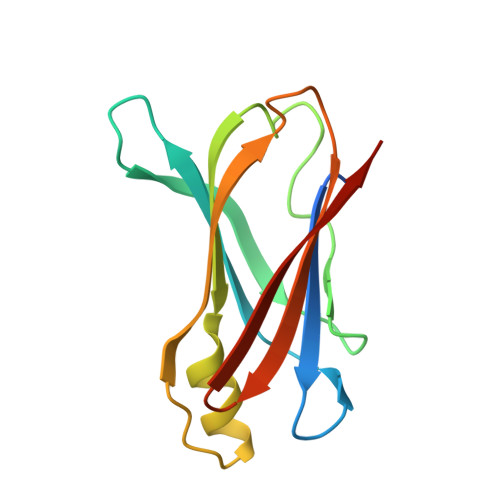Structural insight into pH-induced conformational changes within the native human transthyretin tetramer.
Palaninathan, S.K., Mohamedmohaideen, N.N., Snee, W.C., Kelly, J.W., Sacchettini, J.C.(2008) J Mol Biol 382: 1157-1167
- PubMed: 18662699
- DOI: https://doi.org/10.1016/j.jmb.2008.07.029
- Primary Citation of Related Structures:
3CBR, 3D7P - PubMed Abstract:
Acidification of the transthyretin (TTR) tetramer facilitates dissociation and conformational changes in the protein, allowing alternatively folded monomers to self-assemble into insoluble amyloid fibers by a downhill polymerization mechanism in vitro. To investigate the influence of acidification on the quaternary and tertiary structures of TTR, crystal structures of wild-type human TTR at pH 4.0 and pH 3.5 have been determined to 1.7 A resolution. The acidic pH crystals are isomorphous to most of the previously reported TTR structures, containing two subunits in the asymmetric unit (the so-called A and B subunits) but forming a tetramer through crystallographic symmetry. The pH 4.0 crystal structure reveals that the native fold of the tetramer remains mostly undisturbed. In particular, subunit A of the TTR pH 4.0 structure is very similar to the wild-type TTR pH 7.4 structure with an r.m.s.d. of 0.38 A. In contrast, subunit B of the TTR pH 4.0 structure exhibits several significant changes. The EF-helix (residues 75-81) and the adjacent EF-loop (residues 82-90) show an r.m.s.d. greater than 2.0 A. The acidic residues within this region (Glu72, Asp74, Glu89, and Glu92) undergo significant conformational changes that instigate movement of the EF helix-loop region and make residues Lys70, Lys76, His88, and His90 orient their side chains toward these acidic residues. In particular, Glu89 undergoes a maximum deviation of 5.6 A, occupying Phe87's initial position in the wild-type TTR pH 7.4 structure, and points its side chain into a hydrophobic pocket of the neighboring subunit. In the pH 3.5 structure, the EF helix-loop region is completely disordered. These results demonstrate that acidic conditions increase the susceptibility of the EF helix-loop region of the TTR B subunit to undergo conformational changes and unfold, likely destabilizing the tetramer and identifying at least the initial conformational changes likely occurring within the tetramer that leads to the amyloidogenic monomer.
Organizational Affiliation:
Department of Biochemistry and Biophysics, Texas A&M University, College Station, TX 77843, USA.














